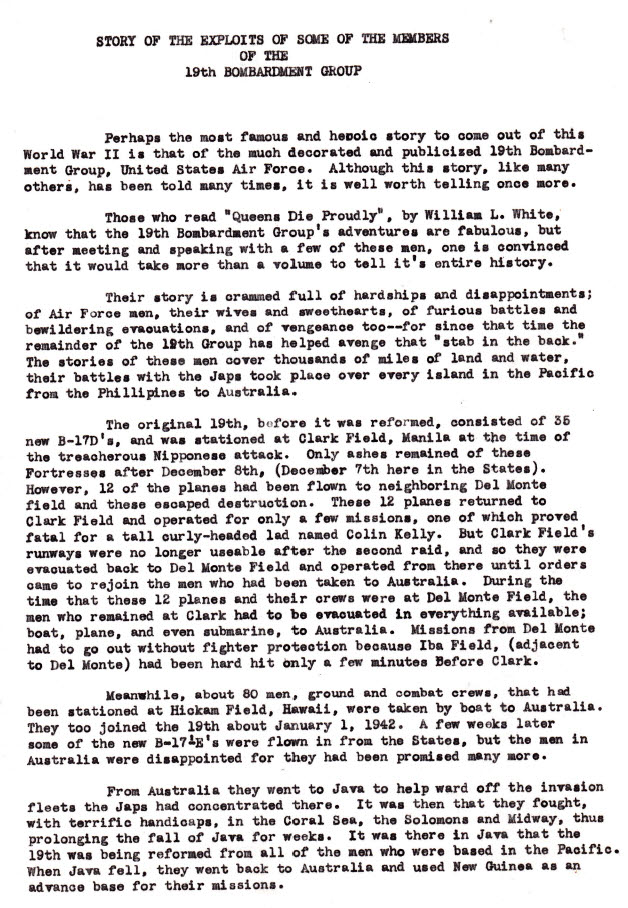
|
|

This introduction originally accompanied a series of paintings by Pfc Ernest Berkowitz, who painted a series of pictures of the aircraft and men of the 19th Bombardment Group while they were all based at Dyersburg Air Force Base, Tennessee, after their exploits in the Far East. Although we don't have the paintings, the stories themselves are still of great interest. Berkowitz later went on to become succesful artist under the name Ernest Berke, mainly producing paintings of Native Americans and their horses.
Many thanks to Dennis Gagomiros for sending us these documents.
STORY OF THE EXPLOITS OF SOME OF THE MEMBERS OF THE 19th BOMBARDMENT GROUP
Perhaps the most famous and heroic story to come out of this World War II is that of the muoh decorated and publicized 19th Bombardment Group, United States Air Force. Although this story, like many others, has been told many times, it is well worth telling once more.
Those who read "Queens Die Proudly", by William L. White, know that the 19th Bombardment Group's adventures are fabulous, but after meeting and speaking with a few of these men, one is convinced that it would take more than a volume to tell it's entire history.
Their story is crammed full of hardships and disappointments; of Air Force men, their wives and sweethearts, of furious battles and bewildering evacuations, and of vengeance too -for since that time the remainder of the 19th Group has helped avenge that "stab in the back." The stories of these men cover thousands of miles of land and water, their battles with the Japs took place over every island in the Pacific from the Phillipines to Australia.
The original 19th, before it was reformed, consisted of 36 new B-17Ds, and was stationed at Clark Field, Manila at the time of the treacherous Nipponese attack. Only ashes remained of these Fortresses after December 8th, (December 7th here in the States). However, 12 of the planes had been flown to neighboring Del Monte field and these escaped destruction. These 12 planes returned to Clark Field and operated for only a few missions, one of which proved fatal for a tall curly-headed lad named Colin Kelly. But Clark Field's runways were no longer useable after the second raid, and so they were evacuated bank to Del Monte Field and operated from there until orders name to rejoin the men who had been taken to Australia. During the time that these 12 planes and their crews were at Del Monte Field, the men who remained at Clark had to be evacuated in everything available; boat, plane, and even submarine, to Australia. Missions from Del Monte had to go out without fighter protection because Iba Field, (adjacent to Del Monte) had been hard hit only a few minutes Before Clark.
Meanwhile, about 80 men, ground and combat crews, that had been stationed at Hickam Field, Hawaii, were taken by boat to Australia. They too joined the 19th about January 1, 1942. A few weeks later some of the new B-17E's were flown in from the States, but the men in Australia were disappointed for they had been promised many more.
From Australia they went to Java to help ward off the invasion fleets the Japs had concentrated there. It was then that they fought, with terrific handicaps, in the Coral Sea, the Solomons and Midway, thus prolonging the fall of Java for weeks. It was there in Java that the 19th was being reformed from all of the men who were based in the Pacific. When Java fell, they went back to Australia and used New Guinea as an advance base for their missions.